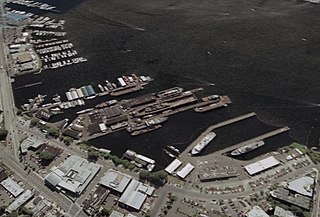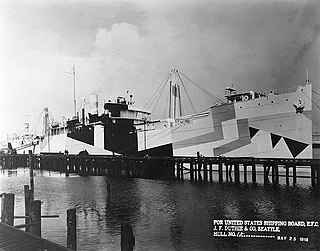
Puget Sound Naval Shipyard, officially Puget Sound Naval Shipyard and Intermediate Maintenance Facility, is a United States Navy shipyard covering 179 acres (0.7 km2) on Puget Sound at Bremerton, Washington in uninterrupted use since its establishment in 1891; it has also been known as Navy Yard Puget Sound, Bremerton Navy Yard, and the Bremerton Naval Complex.

Vigor Shipyards is the current entity operating the former Todd Shipyards after its acquisition in 2011. Todd Shipyards was founded in 1916, which owned and operated shipyards on the West Coast of the United States, East Coast of the United States and the Gulf. Todd Shipyards were a major part of the Emergency Shipbuilding Program for World War II.

Harbor Island is an artificial island in the mouth of the Duwamish River in Seattle, Washington, US, where it empties into Elliott Bay. Built by the Puget Sound Bridge and Dredging Company, it was completed in 1909 and was then the largest artificial island in the world, at 350 acres (1.4 km2). Since 1912, the island has been used for commercial and industrial activities including secondary lead smelting, shipbuilding and repair, bulk petroleum storage, metal fabrication and containerized cargo shipping. Warehouses, laboratories and other buildings are located on the island.

The Admirable class was one of the largest and most successful classes of minesweepers ordered by the United States Navy during World War II. Typically, minesweepers detected and removed naval mines before the rest of the fleet arrived, thereby ensuring safe passage for the larger ships. They were also charged with anti-submarine warfare (ASW) duties with rear-mounted depth charge racks and a forward-firing Hedgehog antisubmarine mortar. Their job was essential to the safety and success of U.S. naval operations during World War II and the Korean War. These minesweepers were also employed as patrol vessel and convoy escorts.
Seaspan ULC provides marine-related services to the Pacific Northwest. Within the Group are three shipyards, an intermodal ferry and car float business, along with a tug and barge transportation company that serves both domestic and international markets. Seaspan, is part of the Washington Companies that are owned by Dennis Washington. Kyle Washington, is the Executive Chairman of Seaspan, who has become a Canadian citizen.


Lockheed Shipbuilding and Construction Company, was a shipyard in Seattle, Washington with Yard 1 on Harbor Island and Yard 2 at what is now Jack Block Park at Seattle Terminal 5, both at the mouth of the West Waterway of Duwamish River. Yard 1 was founded in 1898 as the Puget Sound Bridge and Dredging Company, the company that built Harbor Island, and it was purchased by Lockheed in 1959. Yard 2 began operation in 1943 to build ships for the US Navy. The shipyard was permanently closed in 1988; Yard 2 was sold in 1989, and Yard 1 was sold in 1997, both to Port of Seattle.
Puget Sound Bridge and Dredging Company was a major shipbuilding and construction company, located in Seattle, Washington, on the southwestern corner of Harbor Island, an artificial island in Elliott Bay. The Bridge and Dredging Company created the island, completing its construction in 1909. It established itself in 1898 and engaged in construction projects around the United States and shipbuilding for the U.S. Navy during and after World War II. During the war it also operated under the name Associated Shipbuilders in a joint venture with the nearby Lake Union Dry Dock Company. In 1959 Lockheed purchased the shipyard and it became the Lockheed Shipbuilding and Construction Company. The Yard was permanently closed in 1987.
Lake Washington Shipyards was a shipyard in the northwest United States, located in Houghton, Washington on the shore of Lake Washington, east of Seattle. Today, the shipyards are the site of the lakeside Carillon Point business park. The shipyards built many civilian and U.S. Navy ships.

The Auk class were a class of minesweepers serving with the United States Navy and the Royal Navy during the Second World War. In total, there were 93 Auks built.

The Seattle-Tacoma Shipbuilding Corporation was an American corporation which built escort carriers, destroyers, cargo ships and auxiliaries for the United States Navy and merchant marine during World War II in two yards in Puget Sound, Washington. It was the largest producer of destroyers (45) on the West Coast and the largest producer of escort carriers of various classes (56) of any United States yard active during World War II.

The King and Winge Shipbuilding Company was an important maritime concern in the early 1900s on Puget Sound. The shipyard was located at West Seattle. The owners were Thomas J. King (1843–1925) and Albert M Winge. King was born in Boston and learned to build ships under the famous Donald McKay. He came to Puget Sound in about 1880, and worked in the shipyards of Hall Bros. and T.W. Lake before starting his own shipyard with Winge. King’s partner, Albert L. Winge was a native of Norway.
The Maryland Drydock Company was a shipbuilding company that operated in Baltimore, Maryland during the 20th century.



Puget Sound Naval Shipyard is a large military-industrial complex located in Bremerton, Washington along the north shore of Sinclair Inlet, which opens to Puget Sound. This large shipyard is 1.5 miles (2.4 km) in length along the shore and over a half-mile in width at its greatest distance across. The shipyard has nearly 1,000 facilities such as shipfitters shops, repair shops, drydocks, piers, cranes, crane rails, railways, and tunnels. In addition to the industrial facilities, supporting structures include: residences for officers and enlisted personnel, recreation facilities, boiler, electrical substations, fuel tanks, medical facilities, and canteens. The historic district is just over a tenth of the entire shipyard, 189 acres of the shipyard's 1,347 acres. Its greatest significance was during the Second World War when it repaired large warships damaged in the Pacific theater. It was designated a National Historic Landmark District in 1992.

The Type V ship is a United States Maritime Commission (MARCOM) designation for World War II tugboats. Type V was used in World War II, Korean War, and the Vietnam War. Type V ships were used to move ships and barges. Type V tugboats were made of either steel or wood hulls. There were four types of tugboats ordered for World War II. The largest type V design was the sea worthy 186-foot (57 m) long steel hull, V4-M-A1. The V4-M-A1 design was used by a number of manufacturers; a total of 49 were built. A smaller steel hull tugboat was the 94-foot (29 m) V2-ME-A1; 26 were built. The largest wooden hull was the 148-foot (45 m) V3-S-AH2, of which 14 were built. The smaller wooden hull was the 58-foot (18 m) V2-M-AL1, which 35 were built. Most V2-M-AL1 tugboats were sent to the United Kingdom for the war efforts under the lend-lease act. The Type V tugs served across the globe during World War II including: Pacific War, European theatre, and in the United States. SS Farallon, and other Type V tugs, were used to help built Normandy ports, including Mulberry harbour, on D-Day, 6 June 1944, and made nine round trips to Normandy to deliver Phoenix breakwaters.

James Griffiths & Sons, Inc. was founded by Captain James Griffiths (1861-1943) in Seattle, Washington in 1885. James Griffiths was from Newport, Wales, where he was a captain of a ship. He started as an agent for NYK Line of Japan. James Griffiths ran the company with his sons: Stanley and Bert. James Griffiths & Sons, Inc. entered into a venture with the Olympic Steamship Company in 1936 to form the Consolidated Olympic Company. Consolidated Olympic Company had routes to Long Beach, California, Seattle and Tacoma, Washington, called the Olympic-Griffiths Line. The Olympic-Griffiths Line ship was the SS Olympic Pioneer was a 7,216-ton cargo ships, common freight was lumber and newsprint. Other ships operated were leased.

Astoria Marine Construction (AMCCO) was founded as Astoria Shipbuilding by Joe Dyer is 1929 in Jeffers Gardens of Astoria, Oregon. Joe Dyer's father was a pioneer of early Astoria and operated a family sawmill. Joe Dyer started by building wooden fishing boats at his shipyard. Then added wooden pleasure craft to his product line. Joe Dyer designed and built Columbia River One Design (CROD) boats and boats for the United States Navy. The shipyard was on the east bank of the Lewis and Clark River and the Jeffers Slough. Due to its historical importance the site is on the National Register of Historic Places in Clatsop County, Oregon. Astoria Marine Construction shipyard closed in 2013.















